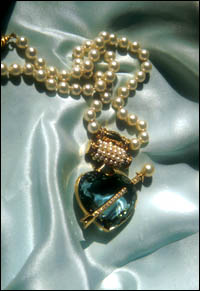


A gem of an exhibition

Kathy Chan of Huntsville, Ala., has won several
international awards for her innovative jewelry.
An exhibition of her work is on display at
the Pinnacle Gallery through the end of September.
Pictured above, "Blue Topaz and Pearl Necklace."
The sparkle of the gemstones Kathy Chan uses to create award-winning jewelry dims in comparison to the sparkle in her eyes.
Working in gold, silver and precious stones, Chan creates stunning yet versatile pieces that can be worn as jewelry or displayed as art. Many pieces have intricate details that require months of work.
An exhibition of Chan's work can be seen through the end of September at the Savannah College of Art and Design's Pinnacle Gallery, located at 320 E. Liberty St.
Her work is sold in galleries and has been exhibited in many museums. In 1992, Chan's jewelry was exhibited with silver artworks by Russian court jeweler Peter Carl Fabergé.
Chan began crafting jewelry 18 years ago. Just over four years later, she won her first international award.
Although the awards she has won denote Chan's mastery, she is a relative newcomer to her field. Now a resident of Huntsville, Ala., Chan was born in China and moved with her family to Brazil when she was 9.
It was in Brazil that Chan discovered her love of gemstones. A teacher whose brother owned a mine took her class on a field trip to see how gems are mined.
"Brazil produces 70 percent of the world's color gemstones," Chan said. "We had to study gems and minerals in school."
When Chan was given an aptitude test, she was told she had a natural ability for engineering. Although she loved art and had talent, Chan's father discouraged her from studying art.
"I wanted to be a dress designer," she said. "My daddy said it was really, really competitive. He said, 'You would never survive. Girls should study language.'"
Chan got married while she was still in high school. "I met my husband when he came to Brazil to see his parents," she said. "He was getting his Ph.D. in England."
Although she earned a high school equivalency diploma, Chan did not begin taking college classes until her three children were in school. After nine years, Chan had earned two degrees from the University of Alabama at Huntsville - the first in modern foreign languages for her father, the second in art for herself.
The study of language is easy for Chan, who is fluent in English, French, Spanish, Portuguese and Chinese. "I can understand some Turkish and Italian," she said.
"I never thought I would design jewelry," Chan said. "I took painting and sculpture. I was designing a logo for a jewelry store, and the owner asked if I wanted to be a partner."
Realizing that jewelry-making can be a form of art, Chan decided to try it. She taught herself casting and the properties of gold, silver and platinum.
Ironically, Chan's work now incorporates engineering and art, two areas of study where she had ability but was discouraged from pursuing. She has received 12 international awards for her creations that include a necklace that can be worn 13 different ways.
Much of Chan's work is sculptural. Often, momentous occasions inspire her to create a piece of jewelry, such as the Challenger space shuttle explosion in 1986 and Operation Desert Storm in 1991.
Three major events of 1989 - the San Francisco earthquake, the march on Tiananmen Square in China, and a killer tornado in Huntsville - inspired commemorative pieces.
Chan created a brooch/necklace to commemorate the tornado, fashioning the pendant into a funnel made of gold, diamonds and rubies. The pendant has 20 rubies on the funnel to represent the people who died in the disaster. The diamonds on the funnel represent the people who were injured.
Small pearls represent buildings, homes and cars damaged in the storm. A teardrop at the tip of the funnel was crafted in rare diamonds to represent Huntsville's unique qualities, while the cultured pearl necklace that the pendant hangs from represents the people who helped in the recovery effort.
The Challenger necklace is crafted in 18-karat gold. Pearls are used to represent the astronauts and the experiments they would have carried out, while the American flag is represented by two diamonds, two rubies and two sapphires.
She also designed a flower-like pendant made of pearls that opens and closes like an umbrella. "There is always some little gadget in my work," Chan said.
"Most jewelry is two-dimensional," she said. "My jewelry is always sculptural. You can almost walk around it."
The sparkle in Chan's eyes comes from the fact that she has developed a very successful business by doing something she truly loves. Nothing in her life turned out as expected, but it's all been for the best, she said.
"I did everything upside down," Chan said. "I met my husband at 17 and got married. I stopped my education to have children. When the youngest went to school, I went to college and got my first degree. By the time my last child went to college, I finished my second degree."
Chan's husband, Tony, is a professor in the University of Alabama physics department. Their daughter Debora is a medical doctor, and their sons, David and Gregory, hold undergraduate and graduate degrees from the Massachusetts Institute of Technology.
Although Chan has a talent for science, her artistic side could not remain buried. "I see colors; I see beauty in flowers," Chan said. "I love bees. I love insects."
Chan is particularly delighted to exhibit her work at SCAD's Pinnacle Gallery. "I'm very impressed with SCAD," she said. "I came to visit when SCAD just started.
"Just 20 years later, it has grown and is so well-known that students from all over the world come here to study," Chan said. "I am so impressed with all the hard work that has been done here."
Linda Sickler can be reached at 525-5500 or by e-mail at lsickler@georgiaguardian.com.
Sitemap | Subscribe | Survey | FAQ | Contact Us
Copyright 2000 Georgia Guardian. All rights reserved.